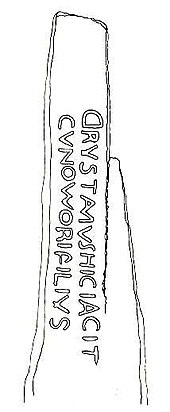Tristan stone
The Tristan stone is a menhir ( English Standing Stone ) from the 6th century, which is located near Fowey on the south coast of Cornwall and was known for its Latin inscription: DRVSTANVS HIC IACIT CVNOMORI FILIVS, which translates as: " Here lies Drustanus, son of Cunomorus ”. Many authors see this inscription in connection with the Tristan and Isolde legend.
Finding
According to Craig Weatherhill, the monolith was originally a few kilometers away, two miles north of Castle Dore , an Iron Age double ring wall from the 2nd century BC. BC, which was reused in the 6th century AD after excavation results from 1936/37 and the discovery of post holes.
The menhir is about 2.7 m high and stands on a modern base, formed from a millstone and weathered hewn stones underneath. Richard Carew first mentioned the monolith in his Survey of Cornwall 1602 without going into the inscription. The monolith bears an inscription on one side and a Christian Tau cross in relief in the form of the Greek Tau , which refers to the 6th century , on the other side below the tip .
The inscription
The vertical two-line inscription is weathered, so that an unequivocal reading is impossible. The ligatures , the mirror-inverted D in Drustanus, and the inverted M in Cunomorus are striking . William Borlase , who published the inscription in Antiquities of the County of Cornwall in 1769 , read CIRVSIVS HIC IACIT CVNOWORI FILIVS. However, since the 1960s at the latest, the inscription has been interpreted as DRUSTANUS HIC IACIT CUNOMORI FILIUS.
legend
The inscription gave rise to speculation in connection with the Tristan and Isolde legend. So Drustanus is seen as the Latinized form of the name Tristan . A King Mark or Marcus was, according to the handwriting of a Breton monk from the 9th or 10th century, a king of Dumnonia , who was also called Cunomurus (Cynfawr) ("quem alio nomine Quonomorium vocant") and was considered the father of Tristan. In the event of a possible equation, even according to the inscription on the menhir, a cunomorus or mark, contrary to legend, would be the father of Tristan before he became an uncle.
Since the inscription is dated to the 6th century, it falls into the period of the legend. In addition, the menhir was originally located near Castle Dore . This is sometimes referred to as the residence of König Marke , although Tintajol / Tintagel , which is also considered the seat of government of King Arthur, is usually mentioned in the processing of the material .
literature
- Charles Thomas: Celtic Britain , Thames & Hudson, London 1986, Reprint Paperback 1997, ISBN 0-500-27935-7 .
- Craig Weatherhill: Cornovia: Ancient Sites of Cornwall & Scilly , Alison Hodge, Newmill, Penzance, Cornwall 1985. ISBN 0-906720-12-5 , pp. 116 and 122.
- Grandpa's opera . In: Der Spiegel . No. 35 1962 ( online - Aug. 29, 1962 ).
Web links
- Tristan in the Encyclopedia Mythica (English)
- The Tristan Longstone (pictures and English text)
Individual evidence
- ↑ Weatherhill, Cornovia , p. 122, see also the legend by Thomas, Celtic Britain , p. 70.
- ↑ a b c Article about Tristan in: Der Spiegel No. 35, 1962.
- ↑ a b c Weatherhill, Cornovia , p. 122.
- ↑ Weather Hill, Cornovia , S. 116th
- ^ A b The Tristan Longstone www.themodernantiquarian.com
- ↑ a b c Thomas, Celtic Britain , p. 70.
- ^ Thomas, Celtic Britain , p. 71.
Coordinates: 50 ° 20 ′ 19.2 " N , 4 ° 39 ′ 14.7" W.

